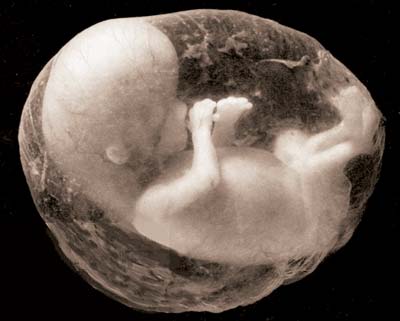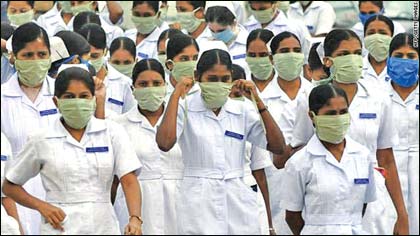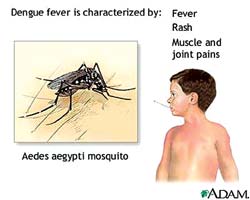|
Health Watch
The last and deadly option!
Nadira GUNATILLEKE
There are problems. There are solutions. Some are very healthy. Some
are not so healthy and some are illegal and deadly! We are talking about
abortion. It says prevention is better than cure. Why take a risk when
there are good solutions available freely?
Do you know the immediate complications of an abortion ? If not read
further. According to the `Unplanned pregnancy and abortion’ published
by the Family Planning Association of Sri Lanka, the bleeding that
occurs due to an induced abortion may be uncontrollable and endanger the
life of the woman.
|

A baby growing inside a womb |
The instruments used at induced abortion and the method of their
usage may lead to infection of the internal organs which endanger her
life. The instruments and the way the abortionist uses them may injure
the internal organs such as the womb and may lead to irreparable injury.
There are many late complications of an abortion. The organs maybe
affected in a way that makes it difficult for the woman to conceive
again. Chronic infections in the internal organs and chronic lower
abdominal/internal pain are another late complications.
Even if she conceives, she will have higher likelihood of having a
pregnancy outside the womb or a miscarriage. The woman may have
difficulties to conceive later.
It is estimated that one in eight pregnancy related deaths occur due
to complications following an abortion. These deaths could have been
prevented if the patients come to hospitals for treatment early.
It is a must to seek immediate medical treatment from a hospital if
lower abdominal pain, abdominal distention, prolonged bleeding, fever,
vomiting, vaginal discharge (profuse, foul smelling, purulent) and feel
unwell after an induced abortion. It will help to save the life of the
patient.
According to the present Sri Lankan law, performing an abortion for
any reason other than to save the life of the mother is a criminal
offense and is punishable by imprisonment.
The Sri Lankan law does not consider a pregnancy with an abnormal
baby as a reason to perform an induced abortion. As induced abortion is
illegal in Sri Lanka, most of the induced abortions are performed under
unsafe conditions leading to major complications and sometimes death of
the mother. Quite often, the so called `doctors’ are unskilled.
The abortion can be easily and safely prevented by using a
contraceptive before the sexual exposure and in an unexpected exposure
(rape) by using emergency contraception within 72 hours of the event.
Persistent and correct use of a reliable method of contraception,
proper knowledge on emergency contraception methods and all the other
methods of contraception, reasonable knowledge on sexual and
reproductive health help to avoid abortions.
Nawaloka offers breast cancer screening
Nadira GUNATILLEKE
According to Consultant Surgeon, Dr.Dilini Samarakoon, around 22.8
percent of female cancers are breast cancers. A six percent rise in
breast cancer has been noticed in Sri Lanka from 1995 to 2000. There are
proved benefits in breast cancer screening and early detection. Its the
key to long survival and to minimize effects on body image (better
cosmesis).
|

Digital picture of a mammogram scan |
Dr. Samarakoon said that mammo grams performed on young females
(bellow the age of 18 and around) does not provided proper images
because of the tenderness of their breasts.
Breasts are still developing at that age. Fully developed breasts
give clearer images. The females between the age of 40 and 65 years of
age need screening. The females in high risk category (with strong
family history) need screening even before that.
Not all females need mammograms. After examining the person, we can
decide whether she needs a mammogram or not. Late presentation, lack of
screening and conservative thinking of women hinder early detection and
better treatment. Breast cancer is inter connected with some other
cancers such as ovarian cancer, she said.
Family history (a very strong link), prolonged menstrual cycles,
nulliparity (childlessness), high fat low fiber diets are some of the
main causes for breast cancer. At the initial stage there will be no
symptoms.
As the cancer grows, a lump or thickening in or near the breast, in
the under-arm area or in the neck, a change in the size or shape of the
breast, nipple discharge or tenderness, or the nipple being pulled back
(inverted) into the breast, ridge or pitting of the breast skin (like
the skin of an orange), a change in the way the skin of the breast,
areola, or nipple looks of feels (warm, swollen, red or scaly) can be
noticed.
Nawaloka now offers breast cancer screening through its Serene Breast
Cancer Screening Unit. Clinical breast examination is available at this
unit for initial assessment and it is done by a female surgeon.
Mammogram is an x-ray of the breast used to see lumps or other
changes in the breast tissue.
Ultrasonography is using high frequency sound waves to see whether a
lump is fluid-filled cyst (usually not cancerous) or a solid mass (which
may or may not be cancerous).
A biopsy will be done to remove a sample of breast tissue to be
tested for cancer cells.
H1N1 pandemic is over - Health Director says
The global H1N1 pandemic is over, the Centers for Disease Control and
Prevention and the World Health Organization said Tuesday.
“We are moving out of the pandemic into the post-pandemic period,”
Director-General of the WHO Margaret Chan said.
|

Indian nursing students wear masks at the Government Gandhi
Hospital in Hyderabad last week |
Chan said that while several countries, including India and New
Zealand, are still experiencing significant H1N1 flu transmission,
out-of-season flu outbreaks are no longer being reported in the northern
or southern hemispheres.
“This pandemic has turned out to have been much more fortunate than
what we feared a little over a year ago,” Chan told reporters in a news
conference Tuesday.
She attributed the end of the pandemic to several factors: that the
virus did not mutate to a more lethal form, the H1N1 flu vaccine proved
to be a good match and widespread resistance to the antiviral drug
Tamiflu did not develop. “This time around, we have been aided by pure
good luck,” Chan said.
The WHO announced the global H1N1 pandemic on June 11, 2009. A
pandemic is a sudden outbreak of a disease that is spread by human
transmission, which quickly becomes widespread and affects a large
region or several countries.
The CDC in Atlanta, Georgia, said the US Public Health emergency for
H1N1 ended on June 23 of this year.
H1N1 is no longer the dominating flu strain. Chan said health
officials are now seeing a mixed virus pattern: In addition to the H1N1
strain, an H3N2 flu strain and Influenza B virus also are circulating.
All three strains are included in the upcoming seasonal flu vaccine.
So H1N1 is not gone, but as the WHO explains, the flu activity health
officials are now seeing is typical seasonal flu activity.
The CDC statement came after an emergency committee of the WHO said
Tuesday the public health emergency triggered by the emergence of the
H1N1 virus “should be considered over.” The committee advised Chan “that
the world was no longer experiencing an influenza pandemic,” the
organization said in a statement.
CNN Wire Staff
Dengue in the air
Nadira GUNATILLEKE
You may wonder what is behind the dengue epidemic which is very
difficult to control no matter how hard the health authorities and all
the other State sector institutions try.

Dengue is still on the rise and there are many preventive measures
taken by both Government and the public. But it seems something is wrong
somewhere. It is not absence of BTI or `Daxtran 40’ or anything else.
Read further to discover what it is.
The main problem still exist without a solution at the grass root
level. It is the persons and groups (they are actually not groups but
aged cliques) which inspects dengue breeding sites located at homes. We
can call them as a part of the public.
According to the information coming from the public, there are many
problems with these grass root level inspection teams. Maybe same
problems exist everywhere in the country without the knowledge of the
next level committee, the Grama Niladhari Level Committee or the
Divisional Secretariat level committee. Some grass root level
‘committees’ hinder the Government’s effort to eradicate dengue!
It is very interesting to see the problems exist with the grass root
level inspection groups which inspect dengue mosquito breeding sites
located in homes and other places. Many of these groups are consisting
of people who are aged and retired, without proper employment or just
housewives.
 Some
of them get tired easily due to their age and unable to carry out
inspections actively for long hours. They are from the same area which
they carry out inspection. Just like any other human being, they have
their own friends and enemies. Some
of them get tired easily due to their age and unable to carry out
inspections actively for long hours. They are from the same area which
they carry out inspection. Just like any other human being, they have
their own friends and enemies.
Those facts have direct negative impact on their duty, which is
inspecting possible mosquito breeding sites within their community. The
aged and retired persons are good at paper work and preach but not for
some active work like walking to locations, inspecting them and
questioning the people. Therefore they always want to stop walking long
distances.
To do this, they speed up their inspection and sometimes they never
inspect. What they do is have a little chat, paste the sticker on the
threshold and walk away.
Unemployed and uneducated persons are more interested in inspecting
other things such as the what people wear, eat, what modern household
appliances they use and more. By chance they may notice the dengue
breeding sites but even then they ignore it (depending on who’s house it
is)!
It is very interesting how these ‘inspectors’ inspect homes belonging
to their friends and enemies. When they arrive at the door step of their
friend, they melt....”Oh after a very long time...nice to meet you
all....how are you doing?” Then comes the chat and then a cup of tea or
a cool drink!
|

These are the lives that are taken away |
They never notice that the cool drink comes from a refrigerator and
it has a water tray where dengue mosquitoes can breed. They see the
beauty and landscape of the garden but not the dengue mosquito breeding
bird bath or water tank. Roof gutters are non-existent for them!
Then they arrive at their enemy’s place. The show starts here! They
see all (non existing) mosquito breeding places all over the house and
in the garden. They try their best to tick the list which says there are
mosquito breeding sites within the property.
They get this chance especially when the land owner have an enemy
next door, who throws all the garbage into his/her neighbour’s garden!
Therefore, the ‘inspectors’ tick the list very happily after inspecting
the garbage thrown into their enemy’s garden by his/her neighbour (who
is a thug!).
Then they visit the next home which belongs to this thug! “Hi how are
you all doing. Its a nice day! How is your family doing? You know we are
here to inspect this dengue breeding sites but we know you don’t have
such places within your property. So take care. We are leaving.”
Then the ‘inspectors’ walk away, and the show ends there. All the
dengue mosquito breeding sites located inside the property stay on
without any damage! Who wants to make enemies and fall into trouble?
This is not an isolated incident that took place in one place only
once. This could be a very common incident that takes place all over Sri
Lanka all the time these days. If the grass root level people (the
public) do not act accordingly and unbiased in their duty, dengue will
not be go away from Sri Lanka.
It will stay here killing more and more innocent children and adults
no matter how hard health authorities and the Government try to
eradicate dengue from the country. The responsibility is in the hands of
the public. Dengue will not go away even the Government import one
million litres of BTI bacteria and spray it from air all over the
country if certain homes are allowed to keep dengue breeding sites by
the community itself.
Checking a person’s health in chakras
Edward ARAMBEWELA
One of Sri Lanka’s Pyra Vastu Consultants and Bio-energetician
Quintin Devanarayana last week checked the health status of centenarian
Buddhist monk Ven. Getapola Wimalaratna Mahanayake Thera (102 years) in
chakras at the Pahalagama Vidya Ravindra Pirivena in Gampaha. In
Chakras, using an alternative medical instrument called ACMOS.
According to this system, there are seven chakras in a person’s life.
It’s connected with health brain, heart, liven and other. All these have
to be in perfect order for a person to be in good health.
With this single cosmic energy based instrument all these chakras can
be checked within a short time.
Following are a few extracts from Devanarayanas report on the
centenarian Monks health sent to the Health Watch Extracts.
“I was able to check the Mahanayaka Thera who is now 102 to trace
whether there is any disorder within him by ACMOS method. I checked for
the functioning of his seven major Chakras.
As you know, Chakras are the energy centres in the pranic or the
energy body of a person. Any disturbance in any chakra, we become
blocked or disconnected with the cosmos.
Then we begin to lose our vitality, go out of balance and it affect a
person physically, mentally and spiritually. Out of the seven Chakras I
checked, his third eye chakra (ajna) was not responding to my
instrument.
Thereafter, I checked his cosmic connection. interestingly, it
worked. Though his ajna chakra was not responding yet having the cosmic
connection is a clear indication that he is in perfect alignment with
the cosmos which shows signs of a good healthy body. For a person to be
in perfect balance all Chakras must be open.
Later I checked for his total energy level. I found more than 10,000
units in my scale measured in microns while an average person’s energy
level with a cosmic connection stands between 6,500-7,000 Units.
As regards, the ajna chakra the major organ related to this is the
eyes. His vision is now weak. I believe this could be due to some
environmental factor.
Any distortion in a Chakra is an indication that some defect or a
blockage is in a part or the whole of a organ related to that particular
chakra.
With a healing process, functioning of the chakras could be back to
normal.
Chakras or the energy body can be analyzed by using this instrument
as their vibrations have been discovered and can be measured with this
method.
To boost up the priest’s energy level I suggested to give a pyramid
charged water so that he will maintain a good physique. Devanarayana has
studied this system in the Vastu World Academy in Poona, India.
Noise sensitivity
The science of sleep:
Susan BRAD
Sleep, sometimes an elusive luxury, is something the body has to
have, on a regular basis, and in fairly standard amounts. Without a
regular 7-8 hours of uninterrupted sleep the body gets cranky. Chronic
sleep deficit causes detrimental effects on one’s ability to remain
alert and attentive, and leads to cumulative effects on performance that
could become a safety risk. Sleep deprivation can also cause
irritability, depression, and contribute to obesity.
|

Sound asleep |
A variety of factors contribute to the enjoyment of a good night’s
sleep, with one of them being the ability to block out noise.
In today’s issue of Current Biology, that ability is demystified by
Dr. Jeffrey Ellenbogen, chief of the division of sleep medicine at
Massachusetts General Hospital, and his researchers.
The study conducted centered on how sensitivity to noise during sleep
is associated with a type of brain activity called sleep “spindles.”
These spindles are described as bursts of fast brain rhythms that
punctuate the otherwise slow-wave patterns characteristic of sleep.
Spindle rhythms originate out of the thalamus, which is located at
the top of the brain stem and is known to affect motor control, and
receive and relay auditory, somatosensory and visual sensory signals.
Researchers believe that the thalamus generates the sleep spindles to
block out those night noises from reaching your brain and waking you. To
test the theory they measured the spindle rhythms in volunteers in a
quiet sleep environment.
Those volunteers were subsequently exposed to two nights of sleep
during which loud noises were introduced. Those volunteers with the
highest spindle rhythm production were less likely to wake up to
auditory stimuli such as road noise and telephones ringing.
Health News |



